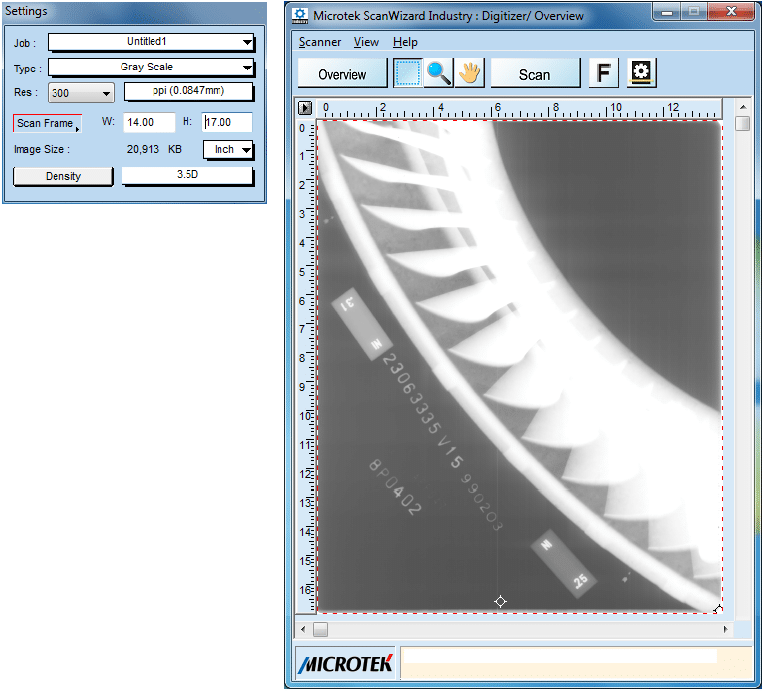What are some common applications of industrial film digitization?
Industrial film digitization has several important applications across various industries. Here are some common use cases:
- Non-Destructive Testing (NDT): Industrial film digitization is widely used in NDT applications. It allows for efficient inspection of welds, castings, and other critical components. By digitizing X-ray or radiographic films, inspectors can analyze defects, cracks, and structural integrity more accurately.
- Aerospace and Aviation: In the aerospace industry, digitized film helps engineers examine aircraft components, such as turbine blades, engine parts, and composite materials. It aids in detecting hidden flaws and ensuring safety compliance.
- Petrochemical and Oil Refineries: Industrial film digitization assists in assessing pipelines, storage tanks, and refinery equipment. It helps identify corrosion, leaks, and material degradation, ensuring operational reliability.
- Automotive Manufacturing: Digitized film is used to inspect automotive parts, including engine blocks, transmissions, and chassis components. It ensures quality control and adherence to safety standards.
- Power Generation and Utilities: Power plants rely on digitized film for inspecting turbines, boilers, and heat exchangers. Detecting defects early prevents costly downtime and potential accidents.
- Railway and Transportation: Film digitization aids in evaluating rail tracks, bridges, and locomotive components. It ensures safety and reliability in transportation infrastructure.
What are the advantages of using digital images over traditional film?
Here are some advantages of using digital images over traditional film:
- Accessibility and Storage: Digital images can be easily stored, retrieved, and shared electronically. They don’t require physical storage space like film negatives or prints.
- Immediate Results: Digital imaging provides instant results. There’s no need for chemical development or waiting time as with film.
- Enhanced Post-Processing: Digital images allow for easy manipulation, enhancement, and analysis. You can adjust brightness, contrast, and apply filters without rescanning.
- Cost-Efficiency: While initial setup costs for digital systems exist, long-term savings come from eliminating film processing, printing, and storage expenses.
- Higher Dynamic Range: Digital sensors capture a wider range of light intensities, resulting in better image quality, especially in challenging lighting conditions.
- Reduced Environmental Impact: Digital imaging eliminates chemical waste associated with film development.
Example how Industrial Film Digitizing System works

Microtek ScanWizard Industry – Digitizer Overview
Microtek International, Inc., the leading manufacturer of NDT Film Digitizer, offers customized pricing to suit client preferences and ensures delivery within a stipulated time frame. They manufacture the NDT-2000 Industrial Film Digitizing System, a practical digitization solution providing industrial digitized images. Used together with MiiNDT, an image analysis and management software, it offers effective solutions for NDT/RT businesses aiming to enter the digital management field.
The NDT-2000 retains the great functions of the previous generation, such as 1200-dpi (21 μm) optical solutions, 16-bit grayscale, and exclusive Automatic Film Feeder (AFF) and Multi-Channel Trays. Additionally, the NDT-2000 adopts better optical density via innovative image technology, enriching image layers to meet high image quality requirements from the NDT/RT industry. This system serves as a turnkey digital transformation solution, complying with industry standards at an affordable price. Here’s how it works:
- Film Loading: Place the industrial film (typically X-ray or radiographic film) into the digitizing system. The film contains the image of the inspected object, such as a weld, casting, or component.
- Scanning: The system uses a high-resolution scanner to capture the film image. It scans the film pixel by pixel, converting the analog information into digital data.
- Image Conversion: The scanned analog image converts into a digital format (usually grayscale). Each pixel’s intensity value corresponds to the film’s optical density, representing the X-ray attenuation through the material.
- Resolution and Dynamic Range: The NDT-2000 system offers high resolution (up to 21 μm) and an extended dynamic range. This ensures an accurate representation of fine details and varying levels of contrast in the image.
- Dust and Scratch Removal: The system employs algorithms to remove dust, scratches, and artifacts from the digitized image. This enhances image quality and reduces the need for manual post-processing.
- Storage and Analysis: The digitized image stores electronically, allowing easy access, retrieval, and sharing. Engineers and inspectors can analyze the image on a computer screen, zooming in for detailed examination.
- Archival and Reporting: The system facilitates long-term archival of inspection records. Reports can be generated, documenting defects, measurements, and annotations.
- Comparison and Measurement: Engineers compare digitized images with reference standards or previous inspections. Measurement tools within the software allow quantification of defects.
Features of the NDT-2000 Film Digitizing System
- Equipped with 1200 dpi resolutions, 4.5D optical density, and 16-bit gray-scale.
- The green LED improves image capturing efficiency.
- Optional Auto Film Feeder (AFF) holds up to 15 sheets of X-ray films at one time.
- Optional Multi-Channel Tray scans up to 3 sheets of 30.5 x 8 cm (12.01” x 3.15”) film simultaneously.
- Supports various sizes of X-ray films from 2.5” x 2.5” to 14” x 200”, offering more flexibility to digitize industrial X-ray films.
- Bundled with multi-functional image management software. This software includes functions such as file building, searching, measuring, annotating, zooming, report making, saving, and burning; meeting the DICONDE standard.
- Supports image formats of DCM, DTI, JPEG, and TIF.
- Supports both lossy and lossless compression formats of JPEG 2000.
- Fully measures up to the DA/DB/DS classes in EN ISO 14096.
- Optional Microtek MiiNDT software inspects information and images together and then saves them into DICONDE format, meeting the ASTM standard.
Contact ABTec Solutions today on Toll Free (800) 775.8993 or reach out and fill the form and we will contact you as soon as possible.



